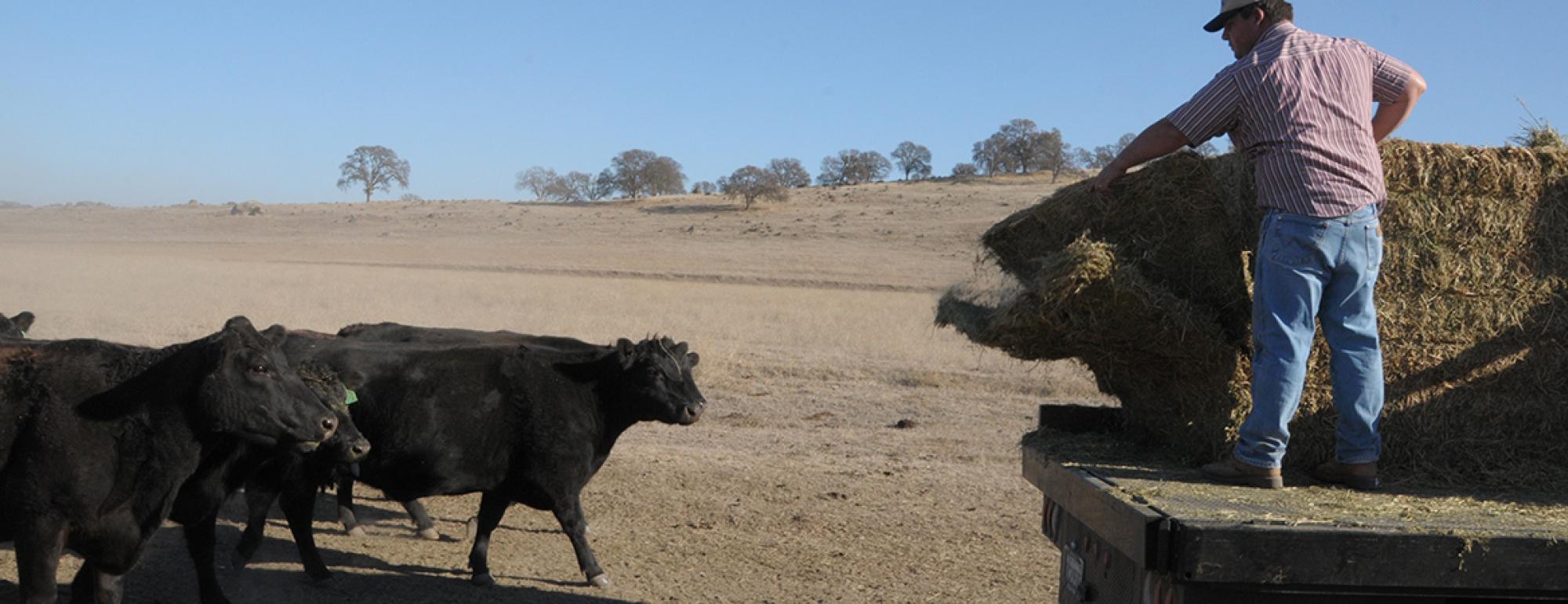Report drought conditions and impacts now!

You can use the Drought Condition Monitoring Observations Report (CMOR) to document drought impacts, report drought duration and affected areas, and share images of impact. Providing real-time, on-the-ground information helps inform the U.S. Drought Monitor's weekly map of drought conditions.
Economics
Economics, Cost of Forage Replacement, and Taxes
Estimating Cost of Replacing Forage
Disturbance on annual rangelands has far reaching ecological and economic impacts on production, and must be appraised on more than traditional grazing rental rates to appropriately compensate producers.
NCBA: Tax Options for Drought Sales of Livestock
Fact sheet addressing two tax options available to producers who are forced to sell livestock due to drought, presented in a question and answer format.
Weather-Related Sales of Livestock
Overview of tax law provisions 1033(e) and 451(e) which attempt to cushion producers from the consequences of adverse weather-related livestock sales, including example calculations.
Management and economic strategies to consider when developing a drought plan.
Feeds & Nutrition
Feeding, Alternative Feedstuffs, and Nutrition
Drought-Related Poisoning and Nutritional Risks to Cattle
Drought can increase the risks of animal poisonings and nutritional imbalances, and the onset of drought‐breaking rains can dramatically alter grazing conditions, posing additional health risks to cattle.
Drought Strategies for Feeding Cattle Grazing Annual Grassland
Drought leads to predictable lack of forage production on rangelands. This publication is designed to help producers think through the supplementation of cattle during drought years.
Use of Alternative Feedstuffs in Cow Calf Operations
Overview of alternative feedstuffs available to California livestock producers, including nutrient information, costs and considerations for managers. More information is available in this presentation!
Limit Feeding Concentrate Diets to Beef Cows
In years when hay and forage production is low due to drought, limit feeding concentrate rations may be an option for some producers to reduce feed costs while maintaining nutritional requirements of cattle.
Drought Feeding and Management of Beef Cattle
Guidelines to assist beef producers in reducing drought-related costs and impacts by managing for the planning, feeding and recovery periods of a drought.
Drought Feeding and Management of Sheep
General recommendations for developing a plan to manage conservation challenges, animal feed requirements, feeding in confined areas and assessing water reserves and quality in drought conditions.
Supplemental Feeds for Cattle Operations during Drought
A guide to using alternative supplemental forages to augment rangeland forage during drought.
Management & Production
Drought Strategies for Feeding Cattle Grazing Annual Grasslands
This UC publication provides information to help producers manage the supplementation of cattle during drought years.
Supplemental Feeds for Cattle Operations during Drought
This UC Publication explores livestock nutritional values of California Agricultural byproducts such as rice straw, almond hulls and more.
Rangelands Special Issue - Drought on Rangelands: Effects and Solutions
This special issue of Rangelands highlights current research on enhancing adaptive management for drought on rangelands.
Livestock Management during Drought
This UC publication provides recommendations for range management, supplemental feeding, and livestock management during drought conditions in California that you may want to consider.
Managing Irrigated Pasture during Drought
This UC publication addresses water availability and drought management for cool season grass pastures in Northern California, as well as discusses the adaptive measures producers can take to sustain pasture productivity both before and after drought.
Drought Strategies for Beef Cattle Culling
Culling cattle is the most direct method of reducing forage consumption on drought-stricken rangeland. This UC publication provides information on strategic culling, which requires the ability to navigate the current year's challenges while considering the necessity of rebuilding cattle numbers in the future.
Managing Drought Risk on the Ranch
This extensive guide can help rangeland managers better prepare for, understand, and manage drought risk (worksheets included!). This work was a project of the National Drought Mitigation Center (NDMC), the University of Nebraska-Lincoln, South Dakota State University, and Texas A&M Kingsville.
Top 10 Drought Management Tips for Ranchers
This brief fact sheet by South Dakota State University Cooperative Extension Service and USDA highlights ten considerations for ranchers to prepare for and/or respond to drought.
Drought Management Strategies for Beef Cattle
This comprehensive guide from the Cooperative Extension System's Cow-Calf Management Library can aid in objective decision making for drought preparation.
Evaluating a Early Weaning Drought Management Strategy
Early weaning can be a useful tool to manage forage supply during a drought while minimizing the need to feed high energy rations or dramatically liquidate cattle. This publication outlines potential scenarios and considerations.
A Drought-Planning Methodology for Ranchers in the Great Plains
The National Drought Mitigation Center (NDMC) at the University of Nebraska-Lincoln worked with ranchers and advisors to develop a drought-planning methodology for ranch operations in the Great Plains. This publication provides step-by-step information based on rancher experiences.
Programs and assistance
USDA Risk Management Agency
USDA information on the Risk Management Agency's (RMA) Pasture, Rangeland, and Forage (PRF) insurance program and decision support tool.
U.S. Department of Agriculture
USDA's latest drought announcements, disaster updates, and US Drought Monitor and Impact Reporter information.
USDA Natural Resources Conservation Service
USDA NRCS offers technical and financial resource programs to farmers and ranchers coping with drought. The USDA NRCS in California also provides information on conservation assistance for California farmers and ranchers. USDA Natural Resources Conservation Service
California Department of Food and Agriculture
Drought information and resources for farmers, ranchers, and farmworkers.
Determining Drought On California's Rangelands
Extensive guide for understanding and managing drought risk, including worksheets.
Research & Extension
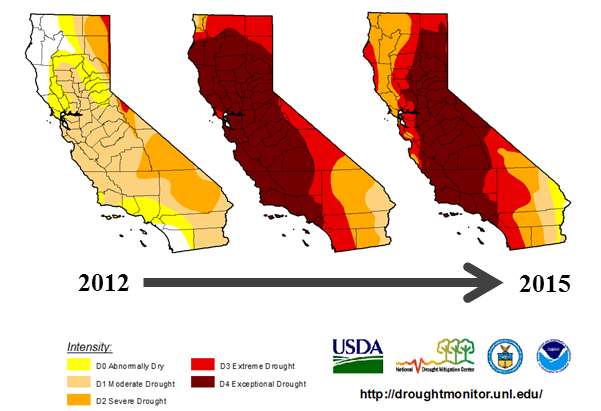
Drought Impacts on California Ranches — Evaluating drought response and recovery strategies
Rangeland livestock producers were among the first agricultural communities affected by California's worst drought in 500 years. Through surveys and interviews, we have worked with the ranching community to identify key strategies for coping with and adapting to drought. Ranchers and rangeland managers have also shared that social media has provided them with new tools for peer-to-peer learning, public education, and extending knowledge to larger audiences. Insights from managers' experiences are important for adaptation planning to enhance resilience of rangeland social-ecological systems to climate stresses.
Recent Publications and Outreach
UC Rangelands Blog. 2017. Coping with drought via adaptive rangeland decision-making.
Macon, D.K., et. al. 2016. Coping with drought on California rangelands. Rangelands 38: 222–228.
Roche, L.M. 2016. Adaptive rangeland decision-making and coping with drought. Sustainability 8: 1334.
Roche, L.M. and K.W. Tate. 2014. Drought: Ranchers' perspective and management strategies. Policy Brief.
Ranching and California's Drought - A Workshop and Webcast
On November 7, 2014, we brought the U.S. Drought Monitor authors and the California State Climatologist to UC Davis to talk about 1) how the U.S. Drought monitor is updated weekly; and 2) how local expert knowledge, real time ranch impacts, and other relevant data can be used to inform the U.S Drought Monitor. We also shared new information on California Ranchers’ perceptions and experiences with drought, new livestock feeding strategies during drought, and seasonal weather forecasts for California.
Workshop and Webcast Videos and Presentations
Welcome from Ken Tate, UC Davis. Presenters: Mark Svoboda, Brian Fuchs, Brad Rippey
Panel - Questions and Discussion about the Drought Monitor and California.
Presenters: Leslie Roche, Glenn Nader, Michael Anderson
Closing Remarks: Justin Oldfield and Tim Koopmann, California Cattlemen’s Association
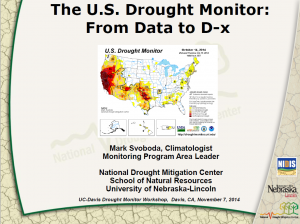 A Behind the Scenes Look at the Drought Monitor: History, Tools, and Methods
A Behind the Scenes Look at the Drought Monitor: History, Tools, and Methods
Mark Svoboda, Climatologist/Monitoring and Program Area Leader/National Drought Mitigation Center/University of Nebraska-Lincoln
As the NDMC’s Monitoring Program Area Leader, Mark’s duties include overseeing the center’s operational national drought monitoring activities. Mark co-founded the development of the U.S. Drought Monitor (USDM) in 1999 and serves as one of the principal authors of both the weekly USDM and monthly North American Drought Monitor products. He currently sits on the American Meteorological Society’s Applied Climate Committee as well as NOAA’s National Integrated Drought Information System (NIDIS) Program Office’s Implementation Team.
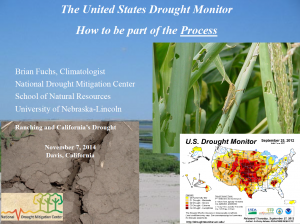 How to Get Information into the US Drought Monitor Process
How to Get Information into the US Drought Monitor Process
Brian Fuchs, Assistant Geoscientist/Climatologist, National Drought Mitigation Center, School of Natural Resources, University of Nebraska-Lincoln
Climatologist with the National Drought Mitigation Center at the University of Nebraska. I am one of the 11 US Drought Monitor authors and have been working in the applied climate field for the last 15 years. My research focus deals mainly with drought monitoring and the development of tools and information for stakeholders.
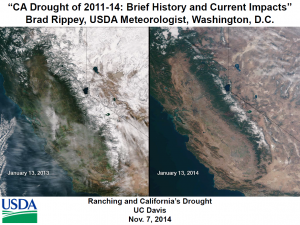 The California Drought of 2011-14: Brief History and Current Impacts
The California Drought of 2011-14: Brief History and Current Impacts
Brad Rippey, USDA Meteorologist Office of the Chief Economist World Agricultural Outlook Board
Brad Rippey is an agricultural meteorologist with the U.S. Department of Agriculture's Office of the Chief Economist, and the managing editor of the Weekly Weather and Crop Bulletin. He is one of eleven rotating authors of the weekly U.S. Drought Monitor. Prior to joining USDA in 1998, Rippey worked as a meteorologist with the U.S. Department of Commerce for more than 10 years.
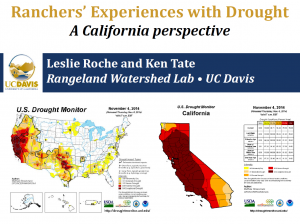 California Ranchers’ Experiences with Drought
California Ranchers’ Experiences with Drought
Leslie Roche, Project Scientist, Rangeland Watershed Laboratory, Department of Plant Sciences, UC Davis
Leslie's research is focused on the economic and ecological sustainability of rangeland livestock production systems. She works collaboratively with ranchers, agencies, and other stakeholders to investigate relationships between rangeland management, livestock performance, soil health, water quality, vegetation dynamics, habitat quality, and sensitive species conservation. Recently, she has expanded her work to include linked social-ecological aspects of ranching such as goal setting, decision-making, and drought adaptation strategies.
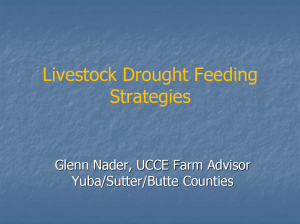 New Livestock Drought Feeding Strategies
New Livestock Drought Feeding Strategies
Glenn Nader, Livestock and Natural Resources Advisor, UC Cooperative Extension.
Glenn is responsible for applied research and education on livestock and natural resources in Yuba, Sutter, and Butte counties. He works with ranchers on feeding strategies for livestock during drought, sustained ranching, ranch budget analysis, general livestock nutrition and health, and marketing. Glenn is a 4th generation California rancher.
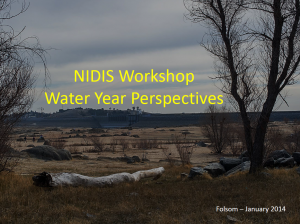 Seasonal Climate Forecast and Opportunity for Q&A’s for the Coming Season
Seasonal Climate Forecast and Opportunity for Q&A’s for the Coming Season
Michael Anderson, State Climatologist, California Department of Water Resources
I provide technical support to programs within the Department related to observations, planning, forecasts, and projections of weather and climate. I have 10 years of experience in my current position and spent the previous 15 years at the University of California Davis getting my advanced degrees and post-doctoral research in the area of hydroclimate studies. For the current drought, I provide information on the historical positioning of the magnitude and duration of the drought, outlooks for future evolution of water conditions, and provide outreach in the form of presentations and interviews. I also serve on the Department’s Drought Management Team.

